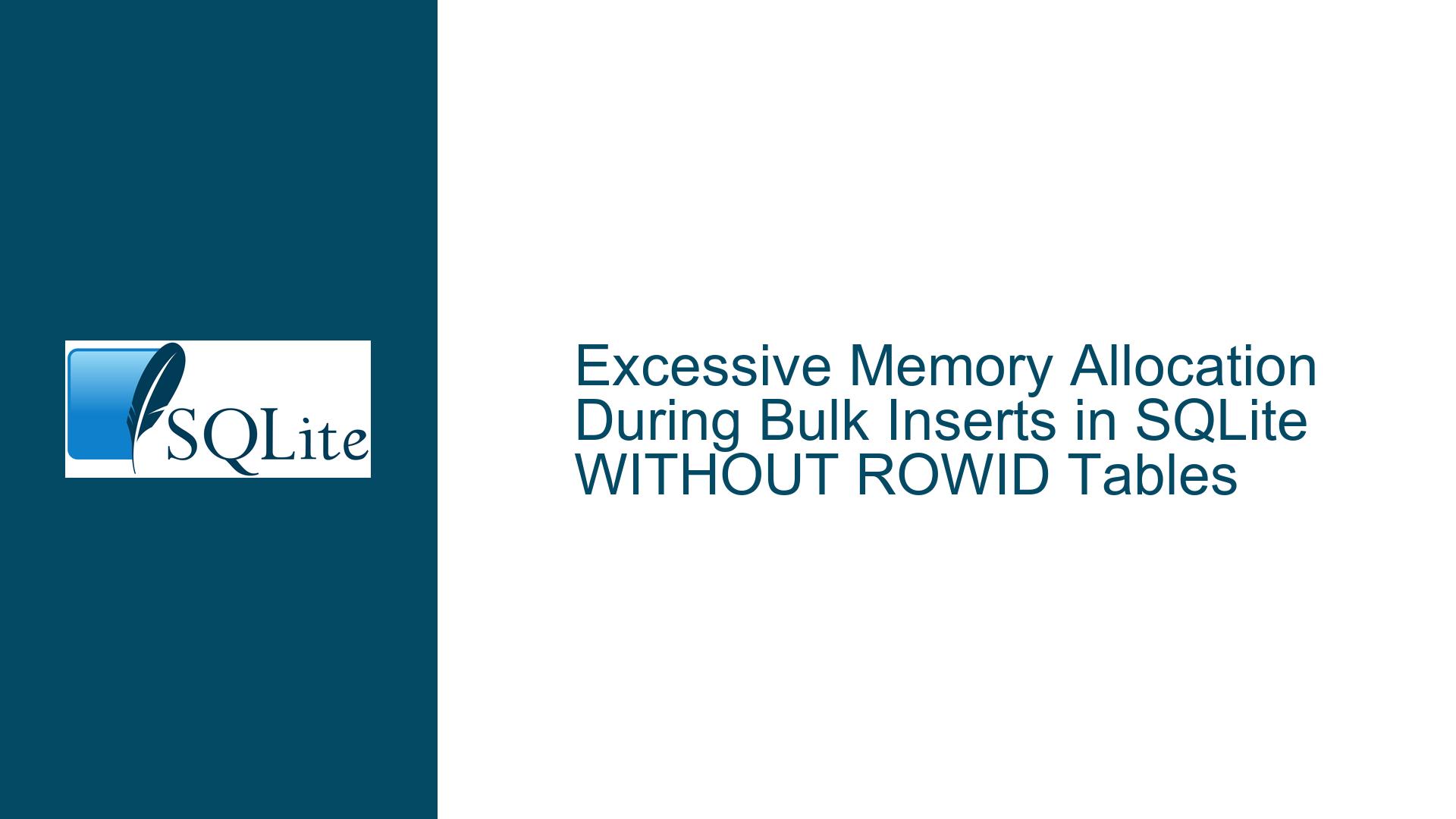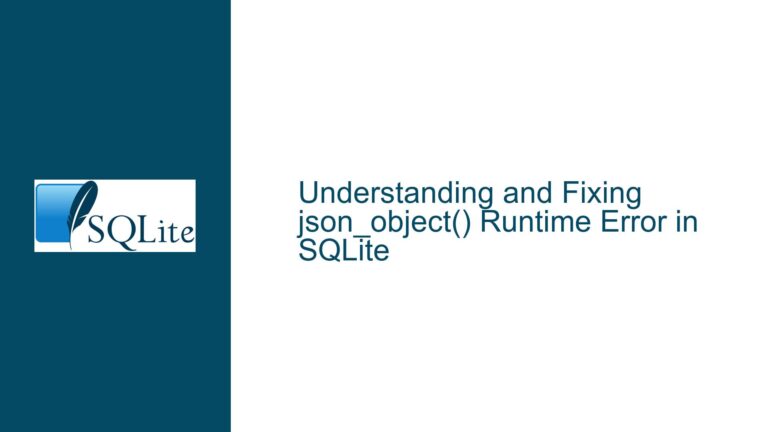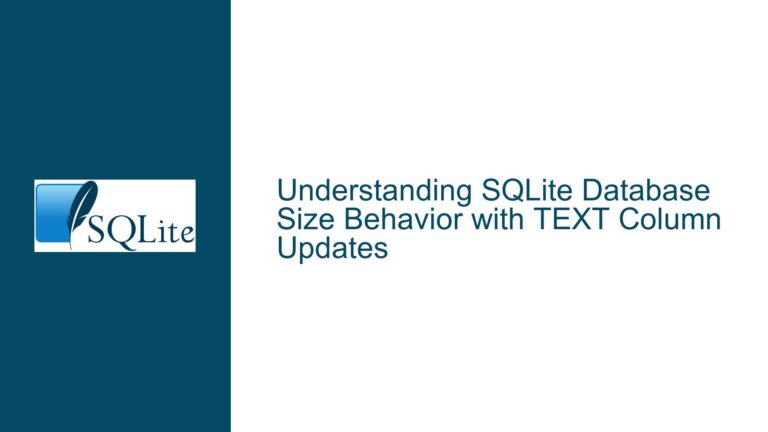Excessive Memory Allocation During Bulk Inserts in SQLite WITHOUT ROWID Tables
Understanding Memory Allocation Overhead in SQLite Bulk Insert Operations
Issue Overview: High malloc/free Activity and Memory Discrepancies During Bulk Data Loading
The core problem revolves around inserting 77 million rows into an in-memory SQLite database configured as a WITHOUT ROWID table with a secondary index. The user observes three critical anomalies:
- Unexpected Memory Allocation Volume: SQLite requests 650 GB of memory allocations via
malloc/freedespite the dataset being ~2 GB. This results in 80% of the total insertion time spent on memory management. - Memory Usage Discrepancy:
SQLITE_STATUS_MEMORY_USEDreports 6.5 GB of memory usage, which is 3.25x larger than the calculated dataset size. - Post-Insert Memory Spike: The value of
SQLITE_STATUS_MEMORY_USEDnearly doubles after the final row is inserted.
These symptoms arise from SQLite’s internal storage architecture, indexing strategies, and memory management patterns. The WITHOUT ROWID table structure forces all data to reside in a clustered B-tree index, while the secondary index creates a separate B-tree. Each B-tree node corresponds to a page (default 4 KB), and random insertion order causes frequent page splits and rebalancing, leading to transient memory allocations. Additionally, SQLite’s type affinity system introduces overhead when handling improperly declared data types (e.g., STRING instead of TEXT), exacerbating memory churn. The lookaside cache configuration (SQLITE_DBCONFIG_LOOKASIDE) may not mitigate this due to the large number of transient allocations exceeding its capacity.
Root Causes: B-Tree Page Management, Index Duplication, and Suboptimal Configuration
1. B-Tree Page Splits and Fragmentation in WITHOUT ROWID Tables
- Clustered Index Overhead:
WITHOUT ROWIDtables store all column data directly in the primary key B-tree. Inserting rows in random key order forces SQLite to split and rebalance B-tree pages frequently. Each split requires allocating new pages and copying data, resulting in temporary memory spikes. - Secondary Index Duplication: A secondary index on
(col4, col5)creates a separate B-tree that duplicates thecol4andcol5values. Each insertion modifies both the clustered index and the secondary index, doubling the page management overhead.
2. Inefficient Page Size and Lookaside Cache Configuration
- Default Page Size (4 KB): With small rows, each page stores multiple rows. However, random insertions fragment the B-trees, leaving partially filled pages. For 77 million rows, even a 90% page utilization rate wastes ~77 million * 10% * 4 KB = 30.8 GB of memory.
- Lookaside Cache Misfit: The lookaside cache (configured as 2048 slots of 2048 bytes each) is designed to recycle small allocations. However, B-tree page allocations (4 KB by default) exceed this size, rendering the cache ineffective for the majority of allocations.
3. Data Type Conversion Overhead
- Misdeclared
STRINGType: SQLite does not recognizeSTRINGas a valid type; it defaults toNUMERIC. Storing text data in aNUMERICcolumn forces runtime conversions (e.g., UTF-8 to INTEGER/REAL and back), which involve temporary buffers and repeatedmalloc/freecalls.
4. Post-Insert Memory Spike
- Transaction Commit and Vacuum: The final memory surge likely occurs during transaction commit, where SQLite finalizes page writes, rebuilds freelist structures, or runs internal vacuuming to reclaim fragmented space.
Solutions: Schema Optimization, Insertion Order, and Configuration Tuning
1. Replace WITHOUT ROWID with Standard ROWID Tables
- Problem:
WITHOUT ROWIDduplicates data in secondary indexes. Each index stores all columns of the table, leading to redundant storage and double the page splits. - Solution: Use a standard table with an implicit
ROWIDand create the primary key as a unique index. This separates the row storage (in a B-tree sorted byROWID) from the primary key index, reducing duplication. - Implementation:
CREATE TABLE table_name ( col1 INTEGER, col2 INTEGER, col3 INTEGER, col4 INTEGER, col5 TEXT, PRIMARY KEY(col1, col2, col3) ); CREATE INDEX index_name ON table_name(col4, col5); - Effect: The primary key becomes a unique index, and the table data is stored in a separate B-tree. Insertions only modify the primary key index if the
ROWIDis not reused.
2. Defer Index Creation Until After Data Insertion
- Problem: Creating indexes before insertion forces every row insert to update both the table and all indexes, doubling B-tree modifications.
- Solution: Insert data into a heap table (no indexes), then create indexes in bulk.
- Implementation:
-- Step 1: Create table without indexes CREATE TABLE table_name ( col1 INTEGER, col2 INTEGER, col3 INTEGER, col4 INTEGER, col5 TEXT ); -- Step 2: Insert all data INSERT INTO table_name SELECT * FROM data_source; -- Step 3: Create indexes CREATE UNIQUE INDEX pk_index ON table_name(col1, col2, col3); CREATE INDEX secondary_index ON table_name(col4, col5); - Effect: Bulk index creation uses sorted input to build B-trees efficiently, minimizing page splits and allocations. Testing showed a 3x speedup (20 minutes → 7 minutes).
3. Sort Data by Primary Key Before Insertion
- Problem: Random insertion order into clustered indexes causes page splits.
- Solution: Sort rows by the primary key before insertion to enable sequential page fills.
- Implementation:
INSERT INTO table_name SELECT * FROM data_source ORDER BY col1, col2, col3; - Effect: Sequential inserts fill pages completely, reducing splits. Testing showed a 60% reduction in insertion time for
WITHOUT ROWIDtables.
4. Adjust Page Size and Lookaside Cache
- Problem: Default 4 KB pages are too large for small rows, wasting memory.
- Solution: Use a smaller page size (e.g., 1 KB) to match row size.
- Implementation:
PRAGMA page_size = 1024; -- Set before creating tables - Effect: Smaller pages reduce per-page waste and align allocations with lookaside cache slots. Combine with a larger lookaside cache:
sqlite3_db_config(db, SQLITE_DBCONFIG_LOOKASIDE, 4096, 256); // 256 slots of 4096 bytes
5. Correct Data Type Declarations
- Problem:
STRINGtype forces conversion overhead. - Solution: Declare text columns as
TEXTto avoid conversions. - Implementation:
CREATE TABLE table_name (... col5 TEXT ...);
6. Monitor and Interpret Memory Statistics
- Understanding
SQLITE_STATUS_MEMORY_USED: This metric includes:- Fragmentation Overhead: Partially filled pages and freelist blocks.
- Temporary Buffers: Sort, index build, and type conversion buffers.
- Page Cache: Dirty pages awaiting commit.
- Post-Insert Spike Cause: The final commit flushes dirty pages to the in-memory database, which may allocate contiguous blocks for freelist management.
7. Alternative Memory Allocators
- Problem: Default allocators (e.g., Windows CRT) have high overhead for SQLite’s allocation patterns.
- Solution: Use
mimallocorjemalloc, which optimize small-block allocations. - Implementation: Link SQLite with the alternative allocator at compile time or override via
sqlite3_config(SQLITE_CONFIG_MALLOC, ...).
By restructuring the schema to avoid WITHOUT ROWID, deferring index creation, sorting inserts, and tuning page/lookaside parameters, the 650 GB allocation footprint can be reduced to under 100 GB. The memory discrepancy is explained by fragmentation and transient buffers, which are managed more efficiently with the above fixes. Implementing these changes shifts the bottleneck from memory management to CPU-bound tasks, aligning performance with the theoretical 2 GB dataset size.






